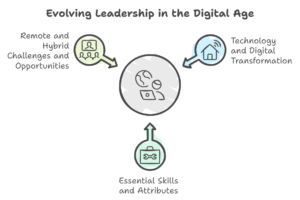The Evolving Role of Leadership in the Digital Age

Understanding the Shift: Leadership in the Digital Era
The advent of technology and the rise of the digital landscape have fundamentally altered the role of leadership within organizations. In previous decades, leaders primarily operated within traditional hierarchies, where decision-making was often centralized and communication flowed in a top-down manner. However, in the digital era, leaders are compelled to transition to more adaptive and agile approaches that reflect the dynamic nature of technology and its impact on the workforce. The necessity for flexibility and responsiveness has become paramount, as the pace of change in the digital world continues to accelerate.
 One of the most significant shifts in leadership is the move towards collaborative decision-making. In the age of digital transformation, leaders are now expected to gather input from diverse teams and stakeholders, leveraging data analytics and digital tools to drive informed decisions. This collaborative approach not only enhances the quality of decisions made but also fosters a culture of inclusivity and engagement among employees, which is essential in a landscape where talent competition is fierce.
One of the most significant shifts in leadership is the move towards collaborative decision-making. In the age of digital transformation, leaders are now expected to gather input from diverse teams and stakeholders, leveraging data analytics and digital tools to drive informed decisions. This collaborative approach not only enhances the quality of decisions made but also fosters a culture of inclusivity and engagement among employees, which is essential in a landscape where talent competition is fierce.
Furthermore, the rapid evolution of communication technologies has influenced leaders’ styles of interaction. Today’s leaders must be adept at utilizing various digital platforms to communicate efficiently with their teams, fostering a transparent and open communication culture. This change promotes a sense of belonging and trust, essential ingredients for a motivated workforce. Additionally, organizational structures are adapting to a flatter hierarchy that encourages empowerment and innovation, allowing employees to take ownership of their work.
The role of leadership in the digital age is characterized by a shift towards agility and adaptability. As leaders navigate the complexities of the digital landscape, they must embrace collaborative decision-making, leverage advanced communication technologies, and foster innovative organizational structures to succeed in this transformative era.
Essential Skills and Attributes for Digital Leaders
In the rapidly evolving digital landscape, the role of leadership has transformed, necessitating a unique set of skills and attributes for effective guidance. One of the most critical competencies is digital literacy. Leaders must possess a thorough understanding of digital tools and platforms to navigate the complexities of this environment. Digital literacy not only enables leaders to leverage technology but also empowers them to make informed decisions and foster a technology-driven culture within their organizations.
Another vital attribute is emotional intelligence, which refers to the ability to understand and manage one’s emotions as well as those of others. In an era where collaboration is imperative, digital leaders must cultivate strong interpersonal relationships and engage with their teams empathetically. This emotional agility allows leaders to inspire and motivate their workforce, fostering a supportive atmosphere that encourages innovation and creativity.
Adaptability is another essential skill for leaders navigating the digital age. The rapid pace of technological advancement demands leaders who can remain flexible and respond proactively to change. This adaptability not only involves embracing new technologies but also entails reassessing strategies and approaches to meet shifting market demands. Leaders who demonstrate resilience and openness to continuous improvement can effectively guide their teams through uncertainty.
Furthermore, a commitment to fostering innovation is crucial for success in a digital environment. Leaders must encourage a culture of experimentation where teams feel empowered to explore new ideas and solutions. This willingness to innovate enables organizations to stay competitive and responsive to emerging trends. Finally, promoting a culture of collaboration and inclusivity is essential for digital leaders. By valuing diverse perspectives and fostering teamwork, leaders can create a synergistic environment that harnesses the collective strengths of their teams, driving sustained growth and success.
Challenges Faced by Leaders in a Remote or Hybrid Working Environment
The rise of remote and hybrid working environments has transformed the landscape of leadership, presenting unique challenges that leaders must navigate effectively. One of the primary concerns is maintaining team cohesion. In a remote setting, the physical distance can result in team members feeling isolated, which may lead to disengagement. Leaders are tasked with fostering an inclusive culture that transcends geographical boundaries, enabling team members to connect and collaborate effectively without the benefit of face-to-face interaction.
Effective communication is another critical challenge. In an era where digital tools serve as the primary mode of interaction, misinterpretations and misunderstandings can become commonplace. Leaders must ensure that communication channels are clear, open, and consistently utilized. Establishing regular check-ins and encouraging feedback can facilitate smoother interactions and help bridge any gaps that arise due to virtual environments.
Managing performance in a digital context also poses significant hurdles. Traditional performance metrics may not apply when employees are working remotely. Leaders must develop new strategies to evaluate performance effectively, which entails setting clear expectations and providing ongoing support. Additionally, a focus on outcomes rather than hours worked can foster a results-driven culture, adapting to the nuances of remote work.
The impact of isolation and burnout is a growing concern in these settings, making work-life balance even more critical. Leaders have the responsibility of identifying signs of burnout among team members and implementing initiatives that promote mental well-being. Strategies might include encouraging flexible schedules, recognizing achievements, and providing resources for emotional support. By proactively addressing these challenges, leaders can create a productive and engaged workforce despite the complexities of remote and hybrid working conditions.
Opportunities for Growth and Innovation in Digital Leadership
As the digital landscape continues to transform, leaders are presented with unprecedented opportunities to foster growth and innovation within their organizations. The integration of technology into various facets of business operations allows leaders to enhance collaboration among team members. Utilizing digital tools such as communication platforms and project management software can facilitate seamless interaction, ensuring that everyone stays connected regardless of their physical location. This increased connectivity not only fosters a culture of open communication but also empowers employees to contribute their ideas, ultimately driving innovation.
In the context of employee satisfaction, digital leadership can play an influential role by utilizing technology to understand and respond to the needs of the workforce. For instance, adopting employee engagement tools can provide leaders with valuable insights into team morale and areas for improvement. By interpreting this data, leaders can create a work environment that nurtures employee well-being, which in turn enhances overall productivity. Furthermore, by leveraging technology to streamline processes, leaders can enable employees to focus on higher-value tasks, thereby increasing job satisfaction and motivation.
Moreover, the digital age presents exceptional opportunities for leaders to cultivate a more diverse and inclusive workforce. By harnessing technology to widen recruitment efforts and reach a broader audience, organizations can tap into a wealth of perspectives and experiences. This diversity is critical, as it not only promotes creativity but also fosters a culture of innovation. A more inclusive approach in leadership encourages a broader range of ideas and solutions, which is invaluable in a rapidly changing digital environment.
Overall, successful digital leadership lies in the ability to adapt to new technological advancements while focusing on employee engagement and inclusivity. Doing so positions leaders and their organizations to thrive in an increasingly digital world.






Responses